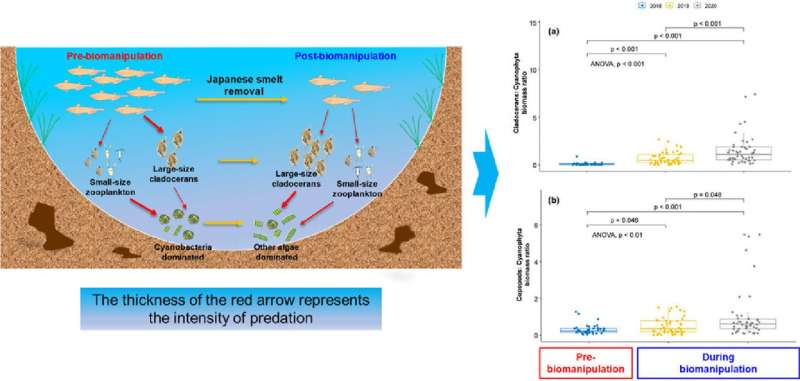Removing planktivorous fish mitigates cyanobacterial blooms in large subtropical highland lake

By enhancing zooplankton grazing ability in northern temperate lakes, planktivorous fish are removed to reduce phytoplankton abundance. It is unclear, however, whether this method will also work in large subtropical highland lakes to alleviate cyanobacterial blooms.
Recently, a research team led by Dr. Guo Longgen from the Institute of Hydrobiology (IHB) of the Chinese Academy of Sciences demonstrated that sustained removal of Japanese smelt led to an increase in the biomass of cladocerans and a significant decrease in the biomass of Cyanobacteria and Chlorophyta. The study was published online in Water Research.
To study the impact of quantitative removal of the Japanese smelt on the aquatic ecosystem, the researchers conducted a fish regulation experiment in situ fencing for the first time. They obtained the optimum fishing effort for this fish removal and applied this to the whole lake.
The researchers analyzed the biomass of fish removed from in situ enclosures and assessed the ecological effects of fish removal through a comparative study. The results showed that removing Japanese smelt between July and November significantly increased the zooplankton density and biomass inside the fence compared to outside. The finding encouraged the researchers to do a whole-lake experiment focusing on removing the dominant Japanese smelt.
In the whole-lake experiment, the researchers assessed the effects of Japanese smelt on zooplankton and phytoplankton before and during fish removal via a one-way Analysis of Variance (ANOVA). The results showed that, after extensive fish removal, the ratio of zooplankton to phytoplankton biomass significantly increased, as did the body size of cladocerans, highlighting the importance of enhanced top-down control for mitigating cyanobacterial blooms.
"We found that, in highland deep subtropical lakes, removing small fish, in this case Japanese smelt, reduces phytoplankton and cyanobacteria biomass through a trophic cascade," said Dr. Guo.
This study provided the first evidence that fish removal may be a feasible additional restoration tool to reduce external nutrient loading in subtropical high-land lakes.
More information: Chengjie Yin et al, Can top-down effects of planktivorous fish removal be used to mitigate cyanobacterial blooms in large subtropical highland lakes?, Water Research (2022). DOI: 10.1016/j.watres.2022.118483
Provided by Chinese Academy of Sciences





















